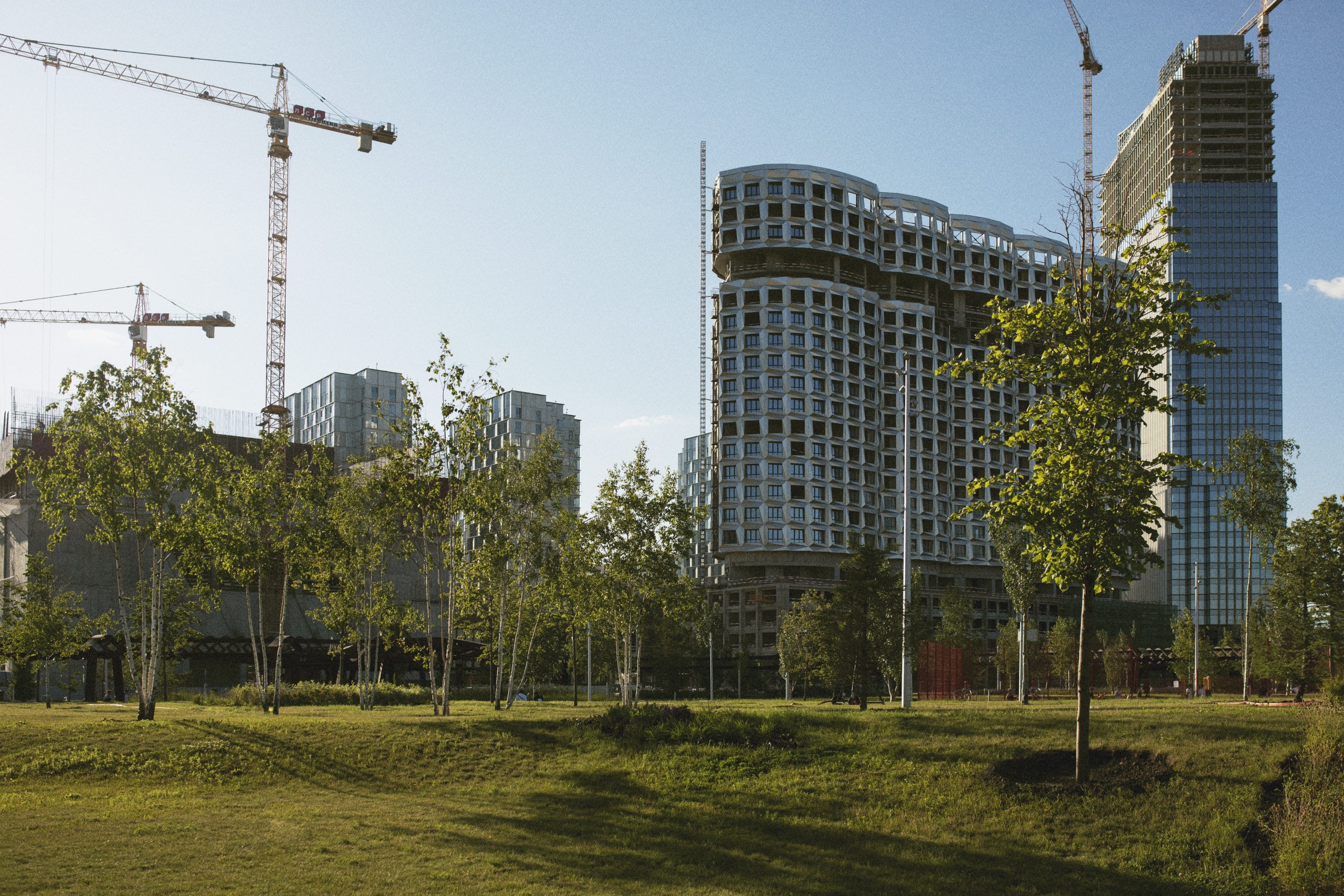
India’s infrastructure boom is accelerating alongside its climate commitments, placing Green Steel and Sustainable Construction at the forefront of new opportunities. As the country expands roads, cities, and industries, it is equally focused on decarbonizing these endeavors—unlocking significant potential for foreign investors to participate in India’s sustainable growth story.
India’s Infrastructure Boom and Climate Goals
India’s construction and infrastructure sector is enormous, projected to contribute $1 trillion to the economy by 2030. It has already become the 6th largest recipient of foreign direct investment, attracting over $35 billion in FDI since 2000. This boom coincides with India’s climate goals—the nation has pledged to achieve net-zero emissions by 2070, meaning the growth of infrastructure must align with aggressive decarbonization.
Key emitting industries are under the spotlight. For instance, steel production is the largest carbon-emitting industrial sector in India and accounts for roughly 7–10% of the country’s CO2 emissions. Without intervention, emissions from steel could double by 2030, jeopardizing climate targets. Likewise, buildings and construction drive significant energy use and carbon output globally. In India, policymakers and developers are increasingly adopting green building practices and energy-efficient technologies to curb this impact. These shifts demonstrate India’s resolve to meet development needs while supporting global climate objectives.
Decarbonising Steel: India’s Green Steel Revolution
The Indian government has launched a concerted drive to produce “green steel” — steel made with low carbon emissions — as a pillar of its industrial decarbonization. The Ministry of Steel is rolling out a National Green Steel initiative, including a special incentive package to accelerate the adoption of low-carbon production methods. This initiative promotes the use of green hydrogen and renewable energy in steelmaking, and supports a transition from coal-based blast furnaces to electric arc furnaces (EAF) and other cleaner technologies. The goal is to curb the steel industry’s heavy carbon footprint and align it with India’s net-zero pathway.
A groundbreaking step in this journey is India’s unveiling of the world’s first Green Steel Taxonomy in late 2024. This framework introduces a star-rating system to classify steel based on emission intensity, with a five-star “green steel” rating reserved for ultra-low emissions (under 1.6 tCO2 per ton of finished steel). Steel produced below a certain carbon threshold will receive green certification, a move expected to spur innovation and global competitiveness in India’s steel sector. The taxonomy, coupled with a proposed Green Steel Public Procurement Policy (to preference low-carbon steel in government projects), provides clear standards and market signals for producers and investors alike.
Major industry players are already responding. ArcelorMittal Nippon Steel India, for example, announced a ₹600 billion (≈$7.2 bn) investment to expand capacity using scrap recycling and renewable power, aiming to earn a top-tier rating under the new green steel norms. Over 65% of the company’s current capacity uses gas-based direct reduced iron (DRI) technology — a lower carbon process — and the new investment will further cut emissions through solar energy projects and advanced energy-efficiency measures. Such moves underscore how India’s steel giants are aligning with government policy: reducing reliance on coal, increasing recycling, and integrating clean energy.
These efforts not only help India meet its climate commitments but also enhance global market appeal. With Europe and other regions increasingly requiring low-carbon materials, India’s push for green steel ensures its exports remain competitive and future-proof. It also opens the door for foreign collaboration—whether through joint ventures to bring in hydrogen-based steel technology, or direct investment in India’s emerging green steel projects. Overall, decarbonising steel is transforming from a challenge into an investment opportunity in India.
Sustainable Construction: Greening the Built Environment
On the construction front, India is witnessing a robust shift toward sustainable building design and materials. Green building certifications are on the rise: India was ranked second in the world for LEED-certified green buildings in 2022, with 323 projects totaling over 10.47 million square meters of certified space. This reflects a doubling of green projects from the previous year and signals strong momentum among Indian real estate developers to embrace sustainability as a standard. From commercial offices to residential complexes, incorporating energy-efficient design, water conservation systems, and renewable energy has become mainstream for forward-looking projects.
Government and industry bodies are actively encouraging this green construction wave. The construction sector is a cornerstone of India’s economy, and stakeholders recognize that integrating sustainability enhances long-term value. Policies like the Energy Conservation Building Code and incentives for green buildings (at central and state levels) are nudging new projects to reduce their carbon and resource footprint. As a result, many modern infrastructure developments — airports, IT parks, metro rail systems, and smart cities — are targeting certifications such as LEED or India’s own IGBC rating, ensuring they meet global benchmarks in sustainability.
The emphasis on sustainable construction aligns with India’s broader climate and urbanization goals. Buildings account for a significant share of energy use and emissions, so making them greener is crucial for meeting India’s nationally determined contributions under the Paris Agreement. Encouragingly, the trend is not limited to high-profile projects; even affordable housing and public infrastructure are beginning to adopt green principles (like passive cooling, rainwater harvesting, and solar rooftops) thanks to increased awareness and proven economic benefits over a building’s life cycle. For foreign investors, this translates into a ripe environment to invest in certified green developments, sustainable building materials, and technology providers that cater to energy-efficient construction.
Policy Tailwinds and Market Incentives
India’s policy landscape is strongly backing the transition to green infrastructure, creating a favorable climate for investors. In addition to the steel sector incentives and taxonomy, the government has streamlined regulations to encourage sustainable projects. Fast-track environmental clearances for renewable energy and clean industrial projects, tax benefits for using recycled materials, and subsidies for electric vehicles and solar adoption in construction are some measures in place. Notably, India’s updated Nationally Determined Contributions (NDCs) call for a significant reduction in emissions intensity of GDP by 2030 and massive expansion of non-fossil energy capacity. These targets send a clear message that infrastructure growth must be low-carbon.
The convergence of economic and environmental objectives is evident in flagship programs. The National Infrastructure Pipeline (NIP), involving over $1.4 trillion of projects through 2025, emphasizes not just building quantity but quality—incorporating resilience and sustainability. Meanwhile, initiatives like the Smart Cities Mission and urban renewable energy mandates ensure that new urban infrastructure embeds green features by design. The introduction of green bonds and sustainability-linked financing in India has further enabled capital flow into eco-friendly projects; in recent years, Indian entities (public and private) have issued green bonds to fund everything from solar parks to metro systems, often attracting overseas investors.
Importantly, India is fostering a collaborative approach with global partners. Through forums like the International Solar Alliance and partnerships for clean technology transfer, India welcomes foreign expertise to bolster its climate agenda. The business environment has also been liberalized in key sectors—100% FDI is permitted under automatic routes in construction development and renewable energy, among others, making it simpler for foreign firms to establish or invest in projects. Together, these policy tailwinds reduce risk and improve returns for sustainable infrastructure ventures, making India one of the world’s most attractive destinations for green investment today.
Opportunities for Global Investors
For international investors and construction firms, India’s twin focus on infrastructure expansion and decarbonization presents a unique dual-benefit scenario. There is a pressing need for capital, technology, and expertise to meet India’s sustainable development targets — a need that overseas partners can help fulfill. A World Bank analysis estimates India will require over $2.4 trillion by 2050 for climate-resilient urban infrastructure alone, and currently only about 5% of urban infrastructure financing comes from private sources. This financing gap highlights immense room for foreign investment in green projects. By partnering in India’s green growth, investors can tap into robust demand while contributing to global climate solutions.
Key opportunity areas include:
- Green Steel & Materials: Joint ventures in low-carbon steel production (e.g. setting up hydrogen-based DRI facilities or financing electric arc furnace upgrades), and supplying innovative materials like low-carbon cement or recycled composites to the Indian market.
- Clean Energy Infrastructure: Investments in renewable energy projects tied to infrastructure (such as solar/wind farms powering industrial clusters or grid upgrades for electrified transit), including emerging areas like green hydrogen production linked to steel plants.
- Green Real Estate Development: Funding or developing commercial parks, factories, and housing projects that are certified green buildings, which not only ensures compliance with future regulations but also meets the growing corporate demand for sustainable spaces.
- Sustainable Finance & Technology: Participation in green bonds, infrastructure investment trusts (InvITs), and climate funds that target Indian projects, as well as providing technology solutions in areas like smart grids, waste management, water recycling, and urban climate resilience.
Additionally, India’s evolving market offers strategic partnership possibilities. Many Indian companies are keen to collaborate with foreign firms to acquire advanced know-how in modular sustainable construction, battery storage, carbon capture, and more. By entering the Indian market now, global players can establish themselves as pioneers in sectors that are set to expand exponentially in the coming years. It’s also worth noting that investment flows are becoming a two-way street. As Indian companies invest overseas (see our analysis on Decoding India’s Outward Investment Trends), the integration of India into global value chains is deepening. This trend strengthens the case for foreign investors to build a presence in India, as partnerships can extend beyond borders, leveraging India as both a market and a source of innovation in sustainable infrastructure.
How T&A Consulting Makes a Difference
At T&A Consulting, we operate at the nexus of India’s sustainability transformation and international investment. As a trusted advisor with on-ground insights, we help foreign investors navigate the complexities of the Indian market and identify viable green investment opportunities. Our team works closely with government bodies, industry associations, and local enterprises to stay abreast of policy developments like the Green Steel initiative and urban sustainability frameworks. This enables us to provide up-to-date guidance on regulatory incentives, compliance standards, and emerging trends that can impact our clients’ investment decisions.
Our approach is holistic and hands-on. We assist clients in everything from market entry strategy and partner due-diligence to structuring projects that meet environmental, social, and governance (ESG) criteria. For example, we advise on aligning projects with green certification requirements or obtaining necessary approvals under India’s evolving climate policies. We also leverage our extensive network to connect foreign firms with credible Indian partners — whether it’s a tech startup in green construction materials or a public-sector entity planning a new sustainable infrastructure project. By bridging international capital and technology with local opportunities, T&A Consulting ensures that investments not only comply with India’s sustainability agenda but also achieve commercial success.
Furthermore, we recognize that insight is key to strategic investment. That’s why we analyze both inbound and outbound investment trends (such as in our Decoding India’s Outward Investment report) to give our clients a 360-degree view of India’s economic landscape. This comprehensive perspective helps investors anticipate market shifts, mitigate risks, and capitalize on synergies across borders. Ultimately, our goal is to make it seamless for investors to be part of India’s green infrastructure revolution — from initial exploration and due diligence all the way to execution and expansion.
Join India’s Green Infrastructure Boom
Are you an infrastructure investor or construction firm looking to explore opportunities in India’s sustainable growth story? Now is the time to engage. India’s push for green steel and sustainable construction is not just a policy mandate but a market reality — projects are taking off, and early movers stand to gain the most. Whether you are interested in funding renewable-powered industrial projects, supplying cutting-edge building technology, or establishing a presence in India’s booming green real estate market, the possibilities are vast.
Contact us at: info@taglobalgroup.com to learn more about current opportunities, receive tailored market insights, or discuss how T&A Consulting can facilitate your India strategy. Join us in propelling sustainable development while unlocking growth in one of the world’s most dynamic markets.




